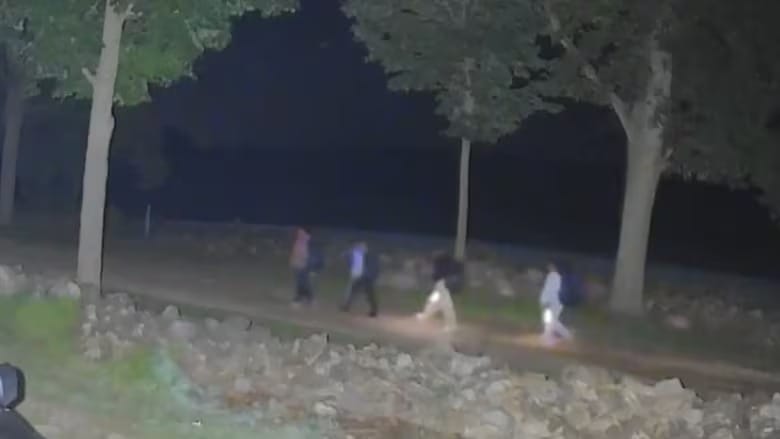Sixteen caught crossing illegally into U.S. from Quebec in days before Trump tariff threat
Canadian law enforcement has limited tools in pursuing networks smuggling people into the U.S.

Late on a Saturday afternoon, two days before U.S. president-elect Donald Trump issued threats to impose tariffs on Canadian goods due to concerns about migrants and fentanyl, the RCMP alerted U.S. Border Patrol about a group crossing illegally from Quebec into the U.S. near Chateaugay, New York.
Border agents initially spotted the group but lost them in the dense forest along the border. Later, around 7 p.m., they encountered a white Acura with New Jersey plates parked on a dirt road near the border. The driver claimed to be looking for a hotel and then drove off. The group remained at large as the day shift transitioned to the night shift. However, just after midnight, the same vehicle reappeared, driving along backroads before picking up passengers, prompting a high-speed chase that reached 140 km/h and ended on a nearby highway.
"There were now six passengers, including one individual in the trunk compartment attempting to conceal himself under backpacks and clothing," stated a criminal complaint filed with the U.S. Federal Court for the Northern District of New York. The passengers, originating from Mexico, Colombia, and Guatemala, admitted to crossing the border illegally earlier that evening.
Between Thursday and Sunday, at least 16 foreign nationals were apprehended crossing into the U.S. from Quebec in three separate incidents, according to court records. Evidence presented in U.S. court documents reveals that human smuggling operations facilitated these crossings, charging between $3,000 and $5,500 per person.
On the following Monday, Trump announced plans to impose 25% tariffs on all imports from Canada and Mexico unless both nations curtailed the movement of migrants and fentanyl into the U.S. The RCMP, however, stated that there is no evidence suggesting that fentanyl produced in Canada poses a significant threat to the U.S.
Rising Border Crossings in Specific Regions
While illegal crossings from Canada are far fewer than those along the U.S.-Mexico border, they have been increasing. Data from U.S. Customs and Border Protection indicates over 21,000 illegal crossings from Canada into the U.S. in the first ten months of 2024, with 18,000 occurring in the region between Quebec and northeastern U.S. states like New York, Vermont, and New Hampshire. This area, known as the Swanton Sector, has seen a dramatic rise in activity over the past two years, with crossings surging from fewer than 1,000 annually to over 6,000 in 2023 and continuing to climb in 2024.
Local governments and residents in New York’s North Country are particularly frustrated by this trend. This region is home to Tom Homan, Trump’s recently appointed “border czar,” and is part of the district represented by Rep. Elise Stefanik, who is slated for a senior diplomatic position under Trump’s administration.
Challenges in Addressing Human Smuggling
Canadian authorities, including Public Safety Minister Dominic LeBlanc, have pledged additional resources such as drones, helicopters, and personnel to combat human smuggling. However, officials acknowledge that law enforcement tools remain limited.
Jeannine Plamondon, a senior legal counsel with the Public Prosecution Service of Canada, has worked on numerous human smuggling cases and explained the complexities involved. Smuggling people out of Canada into the U.S. is not a criminal offense under Canadian law but is prosecuted as a conspiracy to violate U.S. human smuggling provisions. These cases often involve collaboration between multiple agencies across the border.
Plamondon referenced a 2014 case involving a smuggling network that transported Polish nationals from Toronto into the U.S., which required coordination between Canadian and U.S. authorities and took years to resolve.
Calls for Legislative Updates
Experts suggest that Canada should strengthen its legal framework to better address human smuggling. Retired Ontario Provincial Police detective Matthew Eamer noted that Canadian laws currently lag behind those in the U.S., which allow for prosecuting every step of the smuggling process, from harboring individuals to their transportation.
Eamer, who was part of an investigation into a smuggling network linked to multiple deaths in March 2024, highlighted the geographic challenge of securing Canada’s 9,000-kilometer border with the U.S. “The sheer vastness of our border makes it impossible to station officers everywhere,” he said, adding that even advanced technology cannot provide complete surveillance.
Despite efforts on both sides of the border, the increasing activity in regions like the Swanton Sector underscores the difficulties of effectively addressing human smuggling and illegal border crossings.





